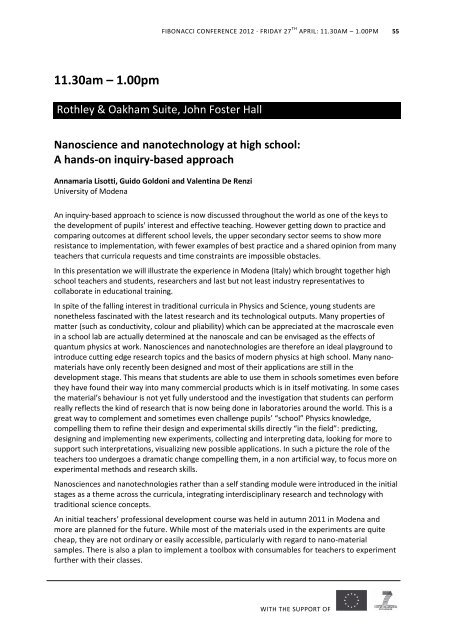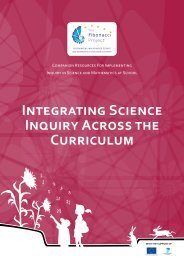disseminating inquiry-based science and ... - Fibonacci-Project
disseminating inquiry-based science and ... - Fibonacci-Project
disseminating inquiry-based science and ... - Fibonacci-Project
Create successful ePaper yourself
Turn your PDF publications into a flip-book with our unique Google optimized e-Paper software.
11.30am – 1.00pm<br />
Rothley & Oakham Suite, John Foster Hall<br />
FIBONACCI CONFERENCE 2012 ∙ FRIDAY 27 TH APRIL: 11.30AM – 1.00PM 55<br />
Nano<strong>science</strong> <strong>and</strong> nanotechnology at high school:<br />
A h<strong>and</strong>s-on <strong>inquiry</strong>-<strong>based</strong> approach<br />
Annamaria Lisotti, Guido Goldoni <strong>and</strong> Valentina De Renzi<br />
University of Modena<br />
An <strong>inquiry</strong>-<strong>based</strong> approach to <strong>science</strong> is now discussed throughout the world as one of the keys to<br />
the development of pupils' interest <strong>and</strong> effective teaching. However getting down to practice <strong>and</strong><br />
comparing outcomes at different school levels, the upper secondary sector seems to show more<br />
resistance to implementation, with fewer examples of best practice <strong>and</strong> a shared opinion from many<br />
teachers that curricula requests <strong>and</strong> time constraints are impossible obstacles.<br />
In this presentation we will illustrate the experience in Modena (Italy) which brought together high<br />
school teachers <strong>and</strong> students, researchers <strong>and</strong> last but not least industry representatives to<br />
collaborate in educational training.<br />
In spite of the falling interest in traditional curricula in Physics <strong>and</strong> Science, young students are<br />
nonetheless fascinated with the latest research <strong>and</strong> its technological outputs. Many properties of<br />
matter (such as conductivity, colour <strong>and</strong> pliability) which can be appreciated at the macroscale even<br />
in a school lab are actually determined at the nanoscale <strong>and</strong> can be envisaged as the effects of<br />
quantum physics at work. Nano<strong>science</strong>s <strong>and</strong> nanotechnologies are therefore an ideal playground to<br />
introduce cutting edge research topics <strong>and</strong> the basics of modern physics at high school. Many nanomaterials<br />
have only recently been designed <strong>and</strong> most of their applications are still in the<br />
development stage. This means that students are able to use them in schools sometimes even before<br />
they have found their way into many commercial products which is in itself motivating. In some cases<br />
the material’s behaviour is not yet fully understood <strong>and</strong> the investigation that students can perform<br />
really reflects the kind of research that is now being done in laboratories around the world. This is a<br />
great way to complement <strong>and</strong> sometimes even challenge pupils’ “school” Physics knowledge,<br />
compelling them to refine their design <strong>and</strong> experimental skills directly “in the field”: predicting,<br />
designing <strong>and</strong> implementing new experiments, collecting <strong>and</strong> interpreting data, looking for more to<br />
support such interpretations, visualizing new possible applications. In such a picture the role of the<br />
teachers too undergoes a dramatic change compelling them, in a non artificial way, to focus more on<br />
experimental methods <strong>and</strong> research skills.<br />
Nano<strong>science</strong>s <strong>and</strong> nanotechnologies rather than a self st<strong>and</strong>ing module were introduced in the initial<br />
stages as a theme across the curricula, integrating interdisciplinary research <strong>and</strong> technology with<br />
traditional <strong>science</strong> concepts.<br />
An initial teachers’ professional development course was held in autumn 2011 in Modena <strong>and</strong><br />
more are planned for the future. While most of the materials used in the experiments are quite<br />
cheap, they are not ordinary or easily accessible, particularly with regard to nano-material<br />
samples. There is also a plan to implement a toolbox with consumables for teachers to experiment<br />
further with their classes.<br />
WITH THE SUPPORT OF




